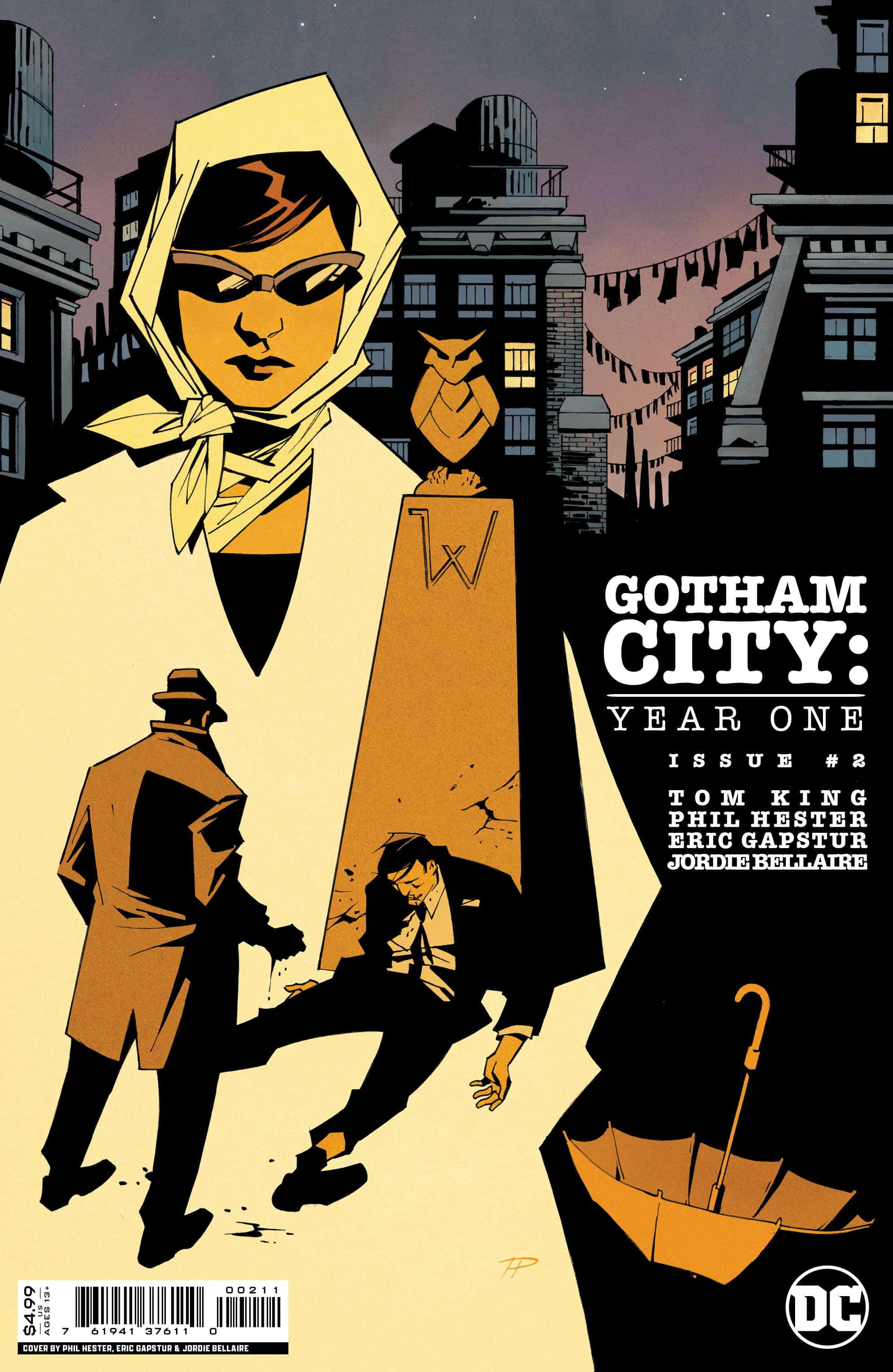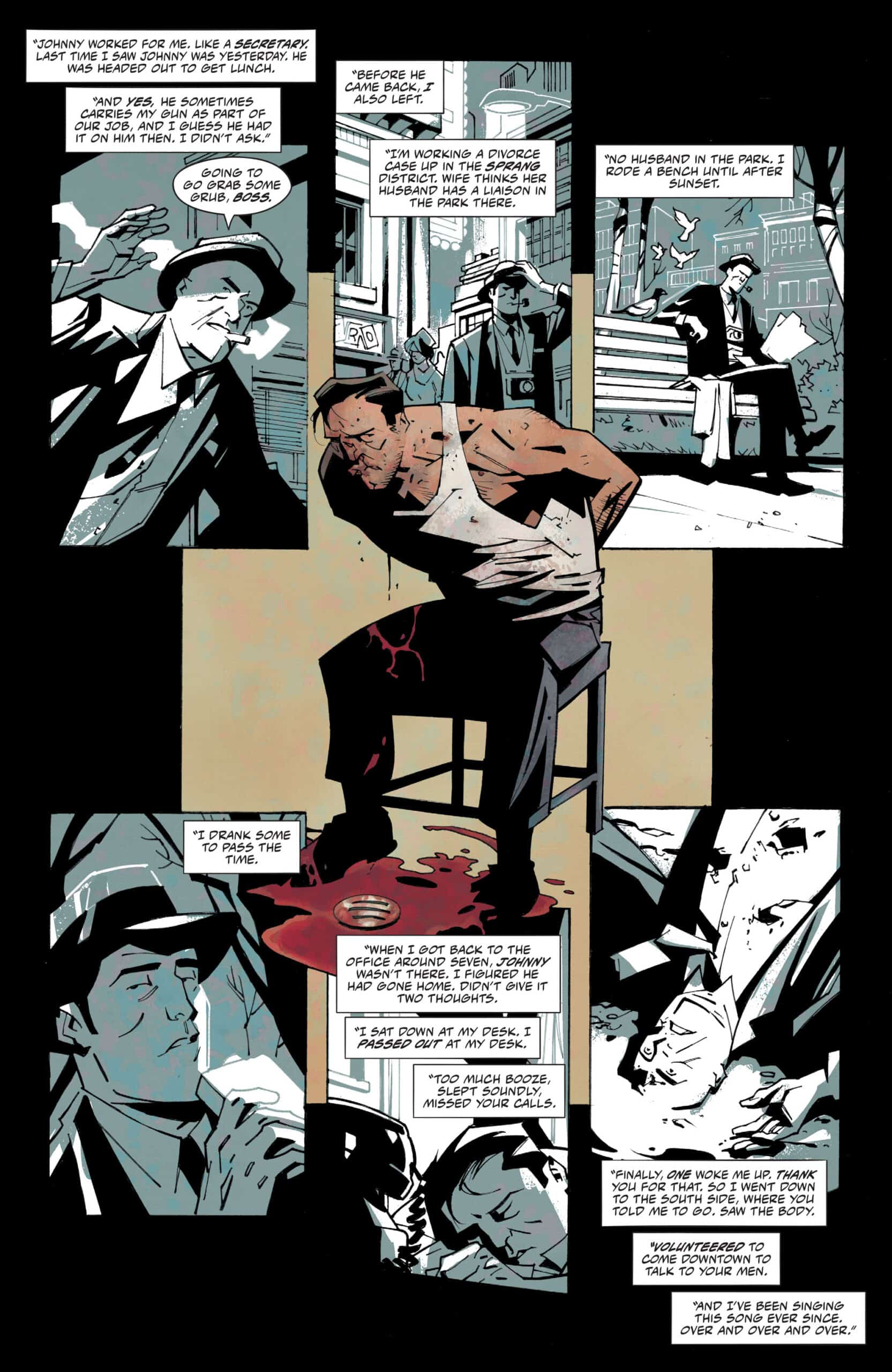Gotham City Year One #2

Recap
The bloody bare-knuckled crime series continues! A bruised and battered Slam Bradley find himself embroiled in a shocking case as the infant heiress to the Wayne fortune has been kidnapped! But as with all the things in Gotham City, nothing is what it seems…can he solve the case in time to save a young life and secure the Wayne legacy or will the secrets of Gotham bury them all?
Review
 Slam Bradley isn’t having a good day. His “clients” think he’s involved in the kidnapping of their daughter, and his friend and secretary is dead. This being a hardboiled detective story, it’s about time for a hard edged cop to sweat Bradley under the hot light of an interrogation room.
Slam Bradley isn’t having a good day. His “clients” think he’s involved in the kidnapping of their daughter, and his friend and secretary is dead. This being a hardboiled detective story, it’s about time for a hard edged cop to sweat Bradley under the hot light of an interrogation room.
Like the first issue, Gotham City Year One #2 makes heavy use of the tropes of the hardboiled detective genre. And like the first issue, it tweaks them just enough to tell a story unique to Gotham. The first issue demonstrated this in the final panels where King reveals that Bradley’s first person past tense narration isn’t simply the employment of a standard genre convention. In fact Bradley is relating these events to Batman. This creates a greater sense of urgency in the second issue because we know Bradley views these events from the past as somehow important to the present.
Usually a writer doesn’t establish a particular reason for why the viewpoint character is relating these experiences nor to whom they are doing so. In answering both of those questions King grounds us in the story in a way we didn’t know we needed to be. He takes a convention we accept without thinking and says, “Don’t take it for granted, there is a reason to tell this story this way.” As a result I wasn’t taking any of the more tropey scenes in Gotham City Year One #2 for granted. I was on alert both for new ways King might play with the story structure as well as what might prove to be important to Batman. It proved to engage me even more than I expected to be as an existing fan of this genre.
This is best exemplified in a character who returns from the first issue to become a larger part of the story and who every reader of this genre will instinctually not trust. Clearly aware of this, King leans into that expectation. He doesn’t set up the end as a conflict between Bradley and this other character who we already distrust. Rather, King has Bradley express his own mistrust and then creates a conflict with Richard Wayne who is pressing Bradley into ignoring his own good sense.
King also doesn’t spin Bradley’s character development or the story off in a new direction after the Batman revelation from the end of last issue. It doesn’t feel like he’s winking at the reader by making Gotham City Year One #2 suddenly about Batman with every moment looked at through that prism. The issue’s developments feel organic–with one possible exception.
In a general sense, avoiding spoilers, Gotham City Year One #2 sees Bradley questioned hard about his dead secretary before being thrust even deeper into the situation with the Waynes (which he is keeping secret). King paces the issue very well, stringing you along just enough until the final pages which break into a dead run. But the moment that kicks up the pace does feel like a wink. What happens makes complete sense in context–so much so that readers will likely see it coming much as Bradley did. But the exact way it happens and Bradley’s on-the-nose comment about it reads like King saying “See, it’s still Gotham.” This is definitely an instance of liking something that happened but not liking how it happened.
I commented in my previous review for the series that far from being dour and moody artistically, the first issue was very much alive. Bellaire’s color palette was lighter (if not bright) than might be expected. And Hester and Gapstur delivered a Slam Bradley whose jawline evoked Dick Tracey. It turns out that this was a perfect way to set up Gotham City Year One #2 which narratively feels colder. Bradley has been beaten up pretty badly at the start of the issue, and even once he’s cleaned up and bandaged he never quite gets that jawline back–and he certainly never resembles that trim, upstanding, approachable but strictly professional man introduced in the first issue’s opening pages. This contrast goes a long way in communicating Bradley’s physical distress. A change in posture, a slack jaw–these details convey more than a heavy application of swelling and bruises.
Bellaire also plays with color more in this issue and creates some interesting moods throughout. In one instance Bradley is meeting with the same woman who sent him on the messenger job that got him involved with the Waynes in the first issue. The two are in Bradley’s apartment which is dark except for the light above his stove. The woman sits on a couch across from the kitchenette, in the dark. Bradley stays mostly in the light, occasionally straddling the middle but never fully entering the darkness until the woman is on her way out.
The second instance sets a more obvious mood: Bradley on his way to a rooftop meeting and having to go up a red lit stairwell to get there. He emerges from the red staircase into the open air of the roof, reconsiders his course out of suspicion, re-enters the red staircase, and finally returns to the roof. Bradley’s indecision is a result of suspicion, and that stairwell is practically Bellaire jumping up and down to reinforce what King is already telling us in the narrative. As shocking–in its way–as the end is, this sequence is what sticks with me from the issue.
Final Thoughts
In all honesty, part of me was worried going into this issue that I was so enamored of the first one that this might not live up to the high bar I felt these creators had set for themselves. I needn’t have worried. These are creators who clearly understand not just their story and the genre it’s a part of, but how to use the ordinary conventions of that genre to tell the story even better. Gotham City Year One was essential hardboiled fiction last issue, and it’s essential hardboiled fiction again this issue.
Gotham City Year One #2: Take Nothing for Granted
- Writing - 10/1010/10
- Storyline - 10/1010/10
- Art - 10/1010/10
- Color - 10/1010/10
- Cover Art - 10/1010/10





